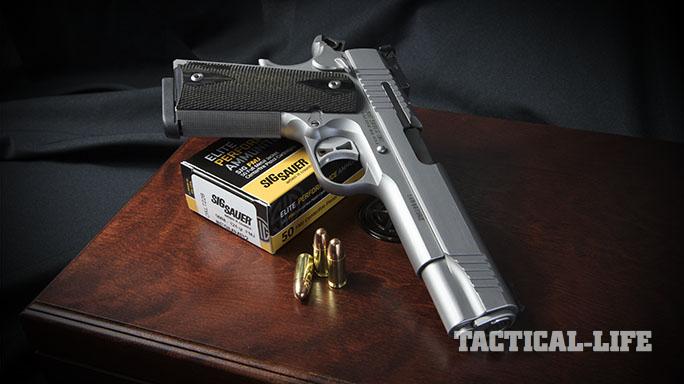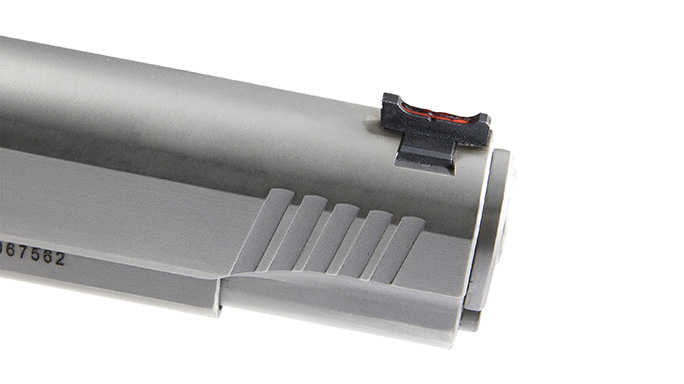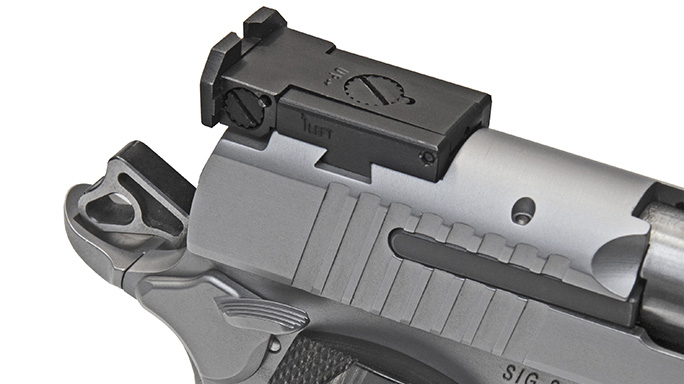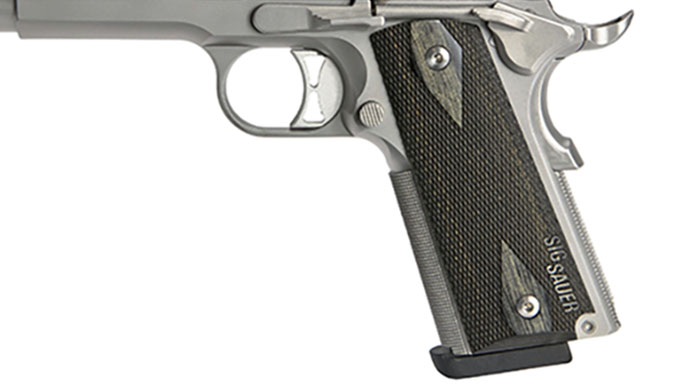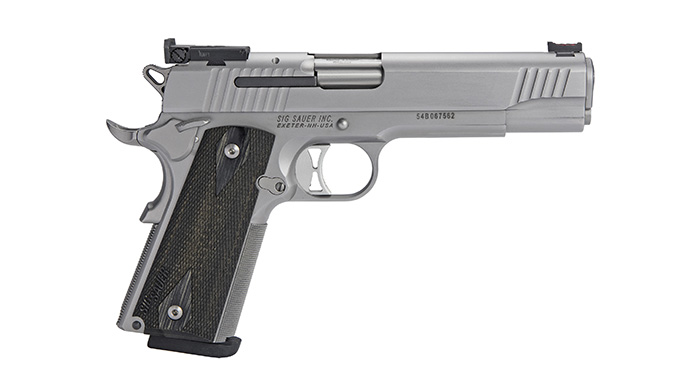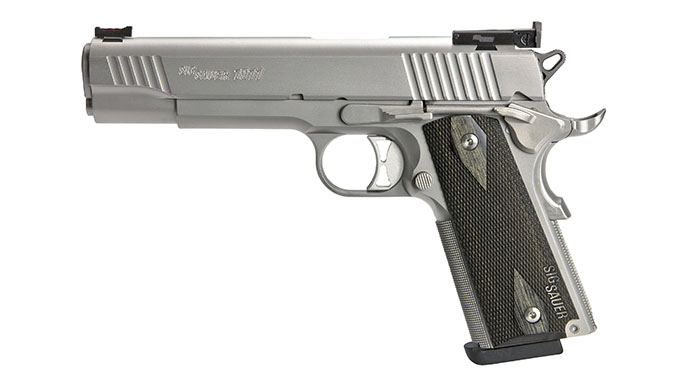It’s been six years since the 1911 pistol had its 100th birthday party. Recently, I spent part of a Sunday afternoon tuning into some sports and outdoor TV shows, noting that several firearms programs featured 1911s. One show had a famous sponsored shooter introduce the features of the pistol’s design to viewers, almost as if thumb safeties, beavertail grip safeties and short, crisp triggers were the “latest thing.” I chuckled as I realized that an entire generation of new shooters doesn’t yet know about John Moses Browning’s gun.
If you’re one of those shooters getting to know the 1911 for the first time, you are in for a treat. The sidearm formerly known as “Old Slabsides” is now available with all of the refinements afforded by modern technology, plus a long list of customization options. You can have a reliable, accurate 1911, and you can have it your way—without mortgaging your house to pay the gunsmith.
To The Nines
Advertisement — Continue Reading Below
Top shooters have been using custom grips, better sights, ambidextrous or extended safety levers, aftermarket triggers and magazine releases for decades. Yet none of these are as exciting to 1911 fans as the addition of new chambering options, especially 1911s in 9mm.
“Having a full-sized, all-steel 1911 in 9mm is so good it feels like cheating,” said one legendary IPSC/USPSA shooter now sponsored by a large manufacturer of 1911s. It almost goes without saying that the characteristics of the 9mm cartridge, paired with an ergonomic, 5-inch-barreled, 38-ounce gun, should make for some gleeful smiles (plastered on otherwise serious faces) at the range.
After running 1911s in .45 ACP for years, I decided it was high time to get in on the action with a new 9mm variant. I ended up choosing Sig Sauer’s Match Elite Stainless in 9mm—one I’m very pleased with.
Advertisement — Continue Reading Below
Match Elite Stainless
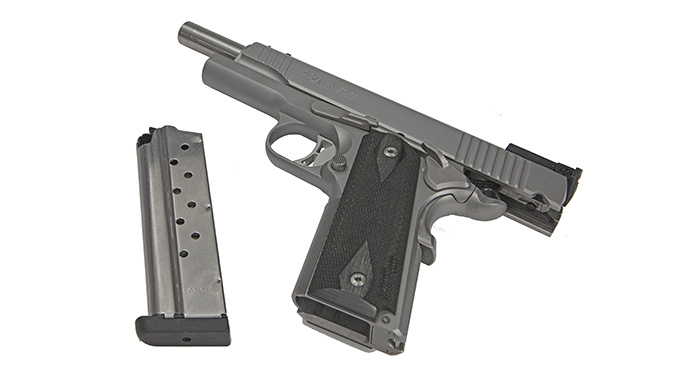
For the 1911 purist out there, I acknowledge that this Sig model is not completely true to the original design. It has modifications, like an external extractor, that set it apart. I think this kind of modest refinement to the trusty old 1911 is a good thing. Some may differ with me on this or that point, but if you are considering a 1911 in 9mm, you are already a big step away from the original. If you want something more true to form, various “GI” and “mil-spec” models are available. This is certainly not one of those.
But there are some notable “traditional” features here, including the slide, which is rounded on top like older 1911s. My first Sig 1911 was a Scorpion model sporting a bulky, squared slide profile. For those unfamiliar, most Sig Sauer 1911s have something like an older Caspian 1911 slide. Not only do they look and feel different than standard 1911s, but by and large, these slides do not fit molded 1911 holsters. With this traditional slide, however, your gear options abound.
The Match Elite Stainless is a full-sized, Government-style pistol with a 5-inch barrel. It does not incorporate an accessory rail into the dust cover like a tactical-oriented model. The Match Elite Stainless is geared more toward competition with a match-grade barrel as well as a match-grade hammer, sear and trigger group. The slide and frame are forged from stainless steel and then hand-fitted to create very a smooth action that locks up solidly. It feels like a custom gun in the way it cycles. Also, the barrel has traditional land-and-groove rifling, which allows shooters the widest variety of ammunition choices because it can handle lead bullets, if you so choose.
Advertisement — Continue Reading Below
The stainless finish gives this pistol a handsome look with a smooth, satin-like feel to the polished surfaces. The frontstrap has 25-lpi checkering while the mainspring housing has 20-lpi checkering. The grip panels are checkered blackwood. Overall, the gun feels great in hand, and everything works together to provide excellent control over the gun, helping you maintain your grip during rapid strings of fire.
The Match Elite Stainless comes with a fiber-optic front sight and a fully adjustable, two-dot rear sight. Some shooters are accustomed to a blacked-out rear sight in this configuration, but I find the dots very familiar and natural to use. I was surprised by the sharp edges on the rear sight, however. I quickly discovered that this sight doesn’t blend nicely with my slide racking technique. After a couple of “bites,” I found myself using the slide release or, alternatively, the front serrations to manipulate the slide, though I suppose the thumb-and-forefinger “slingshot” method would work as well. The same goes for the rear slide serrations, which are quite sharp and pronounced, but they do the trick when grasped firmly and deliberately. Get sloppy, though, and you may end up with some raked knuckles when you load and make ready.
The slide and magazine release buttons are fairly standard, but the gun also sports an ambidextrous thumb safety. It seems a little on the small side, but it’s still easy to operate. A subtle safety lever like this one is less likely to accidentally get bumped off of “safe” should the outboard side of the gun rub against something while holstered. Some oversized ambidextrous designs have a tendency to get snapped on or off by accident in rough-and-tumble situations.
Advertisement — Continue Reading Below
The gun is further distinguished from the original 1911 in several ways. First, as I mentioned previously, it has an external extractor. The wide, pivoting extractor is there to provide reliable extraction as the springs begin to lose tension. I have owned two 1911s with external extractors, the first being a Smith & Wesson some years back, and now the Match Elite. Though my experience with external extractors on 1911s is limited, I can tell you that they have provided me with positive right-side ejection 100 percent of the time. Another addition is the full-length guide rod, which 1911 aficionados seem to love or loathe.
Finally, the Match Elite Stainless has a Colt Series 80-style firing pin block/drop safety, a divisive issue on 1911 forums. Many shooters find these unnecessary (with the right hammer spring strength) while others believe they adversely affect the trigger feel. Comparing this type of 1911 with the Series 70 style (no firing pin block), I cannot tell the difference between the trigger pulls. Personally, I value this feature and am pleased Sig has incorporated it into the Match Elite Stainless.
In fact, the trigger has a crisp, clean break at just over 4.5 pounds. It is a curved and serrated trigger that feels natural and is adjustable for overtravel, though I haven’t adjusted mine. The trigger had minimal overtravel right out of the box. The trigger reset is a shooter’s dream, with very little slack to take up. Because of the excellent trigger and short, positive reset, only the top shooters among us will ever test the limits of just how fast this gun can run.
Advertisement — Continue Reading Below
Range Testing
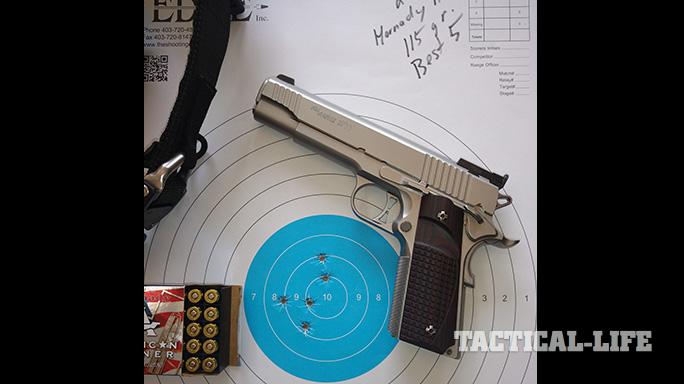
If you’re like me at all, you may tire of reading range reports that all follow the same rote pattern and end with basically the same result: a 25-yard group photo that looks suspiciously like a 10-yard group in the real world. All kidding aside, my experience with this pistol has been overwhelmingly positive, and here’s why.
• Pointability. One thing John Moses Browning nailed is the grip angle, a design spec obviously incorporated into the Match Elite Stainless, along with the vast majority of other production 1911s. It points very naturally toward your intended target. This will be a pleasant surprise for polymer-framed pistol shooters who may be in the habit of having to roll their wrists forward to avoid aiming high.
- RELATED STORY: Sweet Sig MPX – A Piston-Driven & Feature-Rich 9mm Carbine
• Weight/balance. Although I don’t feel that shooting 9mms out of a 1911 is “cheating,” it may be more of a match made in heaven. Compared to the .45 ACP, the 9mm feels more like .22 LR ammo. All of the pistol’s heft helps to mitigate recoil. The muzzle reciprocates straight back with almost no flip and returns like lightning for fast follow-up shots. Rapid, accurate strings of fire are easier in this chambering, and my target-to-target transitions also greatly improved.
Advertisement — Continue Reading Below
• Accuracy and reliability. I could not ask for a more accurate production gun. My initial range test involved 1,000 rounds over two days, with one quick cleaning and re-lubrication after the first 300 rounds. I used the supplied magazines, as well as Chip McCormick 10-round XPs and one from MEC-GAR. All of the ammo fed reliably, though I experienced some failures to go to slide-lock with the aftermarket magazines.
The ammunition was a mix of Hornady 115-grain American Handgunner XTPs, Remington 115-grain HTP +P rounds and Blazer Brass 124-grain FMJs. I have had zero failures to feed or fire, and only one failure to eject. I don’t do much shooting at 25 yards, but I was able to achieve a five-shot group inside of 2.5 inches unsupported. For me, that is more than fine. From 10 yards, at my speed threshold and from the holster, my groups were mostly around 1.5 inches. At one point during my first range session, I emptied a magazine quite quickly, when a buddy remarked that three rounds had gone through the exact same hole. Remember that silly smile I was talking about? Yeah, I got that.
Value & Performance
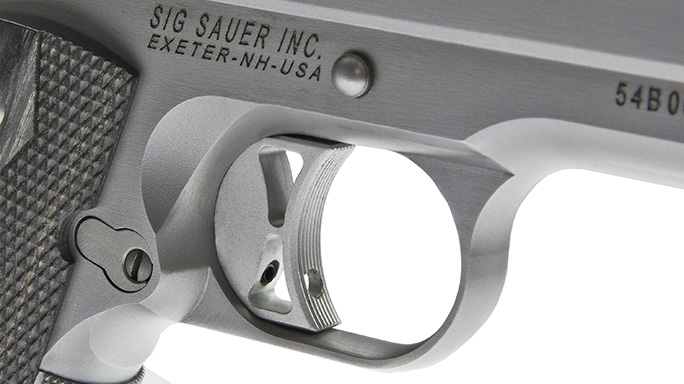
The Sig Sauer 1911 Match Elite Stainless is available in most markets for a very reasonable price, given the features included. Yes, someone may still be able to go out and buy two polymer-framed duty guns for the same money, but to me that isn’t a valuable contribution to the discussion because the items are so vastly different. This gun has a lot of custom features and offers match-grade accuracy for a production price. Another factor is the cost and availability of the 9mm compared to the .45 ACP. I will never get rid of my .45, but it may well see a lot less range time and competitive use with the Sig’s entrance into my safe.
Advertisement — Continue Reading Below
Caliber: 9mm
Barrel: 5 inches
OA Length: 8.7 inches
Advertisement — Continue Reading Below
Weight: 41.6 ounces (empty)
Grips: Blackwood
Sights: Fiber-optic front, adjustable rear
Action: SA
Finish: Stainless
Capacity: 9+1
MSRP: $1,164
For more information, visit sigsauer.com.
